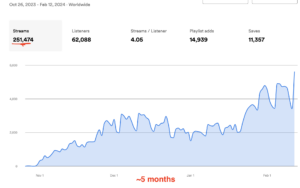If you’re considering using SubmitLink and are looking to verify that they’re a legitimate service before spending money with them, here’s my short answer:
Yes, SubmitLink is legit.
I’ve run campaigns for two tracks on the platform. My most recent submission cost $27 and resulted in three playlist placements which, according to my best estimate, drove somewhere in the neighborhood of 500 streams. From what I can tell, looking at the data in Spotify for Artists and at the playlists themselves, those were all from real, human listeners (not bots).
Obviously, 467 streams is not going to lead to an appearance on The Late Show or end in a big-label record deal – but at a cost per stream of five or six cents, it’s still a solid result. And I like it even more given the fact that I got to handpick the lists I was pitched to, which meant that each one was a good fit for the music.
My biggest issue with SubmitLink at the moment is the simple fact that they don’t have a ton of curators on their platform, which puts a cap on the level of results you can get. Other than that, though, I’m a fan.
The TL;DR version: If you’re looking to supplement your Spotify growth, SubmitLink is a worthwhile spend.
You can give the platform a try yourself here.
And if you want the longer version – with more details on my experiences with the company and my results – then keep reading.
The backstory on SubmitLink
This is probably worth mentioning for transparency’s sake: I actually first heard about SubmitLink directly from Aaron, the founder at the company.
Aaron is also the founder of another platform that I really love – a playlist data software called Artist Tools. In 2022, I’d been using Artist Tools for a while, and I think I reached out to Aaron just to see if he’d be interesting in connecting. To be honest, I really can’t remember the details of how we first got in touch, but I know we sent a few emails back and forth and eventually ended up chatting on a call. At some point, Aaron mentioned he had another playlist submission service called SubmitLink, and that he was interested in getting my thoughts on it.
I agreed to try it out. So, in 2022, I ran a test campaign for an artist I work with.
I came away impressed by SubmitLink, but with no results to show for my spend. The problem, as I told Aaron, was that the curator network on the platform at the time was nearly too small to be useful; I only found four curators I deemed worth submitting to, and given that an average approval rate on these platforms is about 20%, I wasn’t surprised to get rejected by all four.
But I liked the model he was building, so I made a note to try the platform again.
So, in 2023, when I ran an experiment with 16 different Spotify promotion companies, I included SubmitLink. This time around, things went better. (More details on the results in a bit.)
First, though, I think it’s worth explaining…
How SubmitLink works
I’d classify SubmitLink as a do-it-yourself pitching platform, by which I mean two things:
- On SubmitLink, you choose the curators and playlists to which your music is pitched
- There’s no guarantee of results
This is, more or less, the same model that SubmitHub and Groover use. It’s different from the done-for-you pitching model that companies like Indie Music Academy, YouGrow, and others use.
Typically, do-it-yourself pitching platforms result in less streams. But if you use them correctly, they can drive higher-fit placements (meaning that your song will only ever be placed on playlists where it makes sense in context) – and high-fit placements tend to lead to higher engagement rates and, potentially, greater algorithmic growth.
At a very practical level, SubmitLink works like this:
1. You hit the “Promote A Song” button and paste in your song’s Spotify link.
2. You choose between “Manual” and “AI” campaign modes.
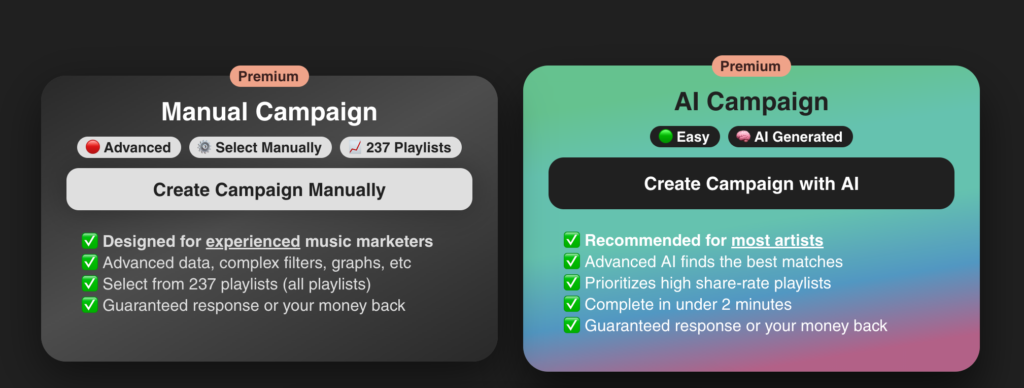
I almost always go for the manual option in these scenarios, because a) I’m skeptical of algorithms and relatedly b) I’m a control freak.
3. Once you choose a “Manual Campaign,” you’ll be taken to the page where you can pick which curators to pitch.
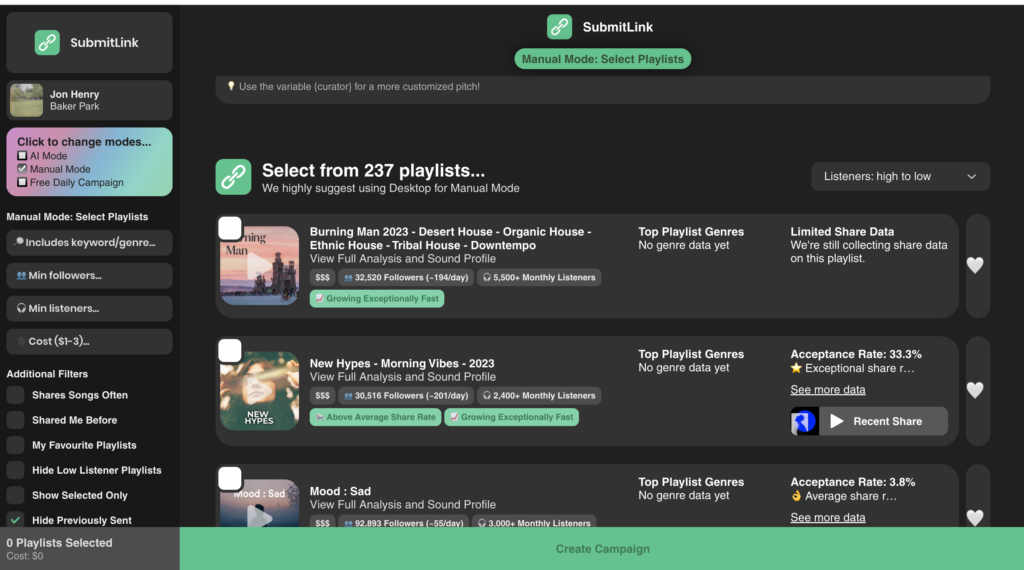
In the main view, you’ll see a scrolling list of playlists. In the left sidebar, you’ll have a bunch of filtering options, including the ability to pare the playlists down based on keywords, genres, number of followers, share rate, and a bunch of other variables
For what it’s worth, this is really similar to SubmitHub’s pitching view – and I consider that a good thing.
4. Once you’ve selected all the curators you want to pitch, you hit the “Create a Campaign” and get taken to a Stripe checkout page.
Submissions cost between $1 and $3, depending on the popularity of the playlist. Submit your payment, and boom – your campaign is live.
It’s also worth noting that you’ll typically see a note to add an audio file for your track. This isn’t strictly necessary, but it is recommended, because if you choose to only include the Spotify link, curators will have to open the app separately to hear your track.

5. You sit back and wait for the results.
You’re guaranteed to get a response from each curator within a week. If a curator doesn’t respond to your submission, you get a refund.
So that’s the process. Next, I’ll break down how it actually played out for my most recent campaign.
My SubmitLink campaign results
To try SubmitLink, I used the song “Messy” by Holly Wild (who was kind enough to let me test her track). It’s a bright, indie pop track that balances upbeat production with a heavier request for vulnerability – the kind of song that feels deeply relatable and simultaneously perfect for blasting with the windows down. I thought it would do well on playlists.
I went through SubmitLink’s process and ended up sending to a total of 14 playlists.
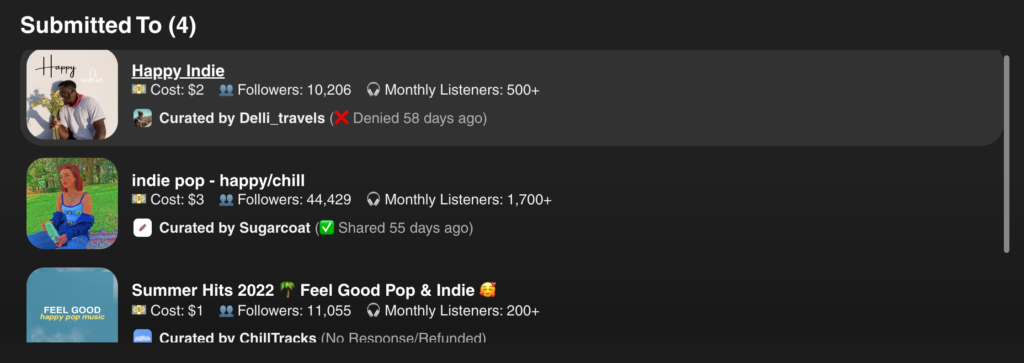
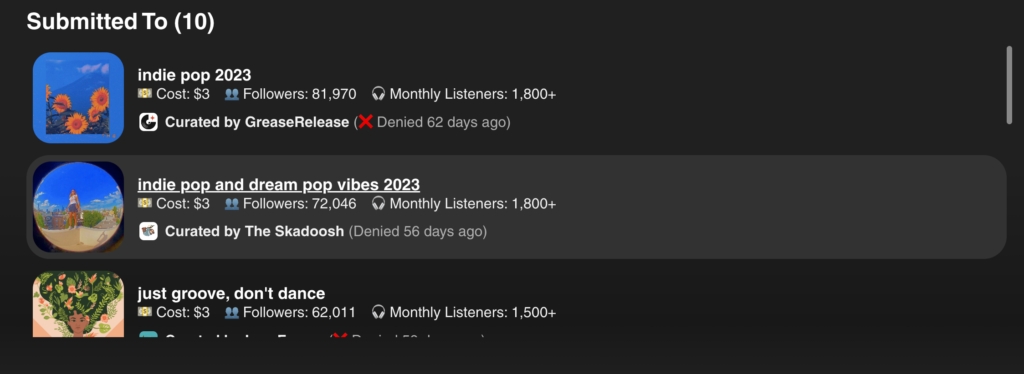
As you can tell by the titles of the playlists, I was looking for indie-pop-focused placements; I picked the ones I thought the song would fit.
Over the next week, the responses from curators came in.

As with any platform where curators are required to respond, most of the feedback is pretty lame. You can react to the feedback, but there isn’t an easy option to chat with curators (as there is on SubmitHub).
That’s par for the course with this stuff, though. You don’t submit music on these platforms for the lame feedback – you do it for the placements.
We ended up getting three of those:
Here’s what the follower growth curve for each of those playlists looks like.

Each of those charts looks pretty good – the lists are trending upward and they don’t show any sharp spikes, which is a good sign for their being built with real, human listeners.
In the backend, the data looked good, too. Holly has done other promotion in the past and gets streams from a wide range of sources, so it’s hard to filter the SubmitLink data out. But here’s what things looked like in Spotify for Artists over the course of the campaign:
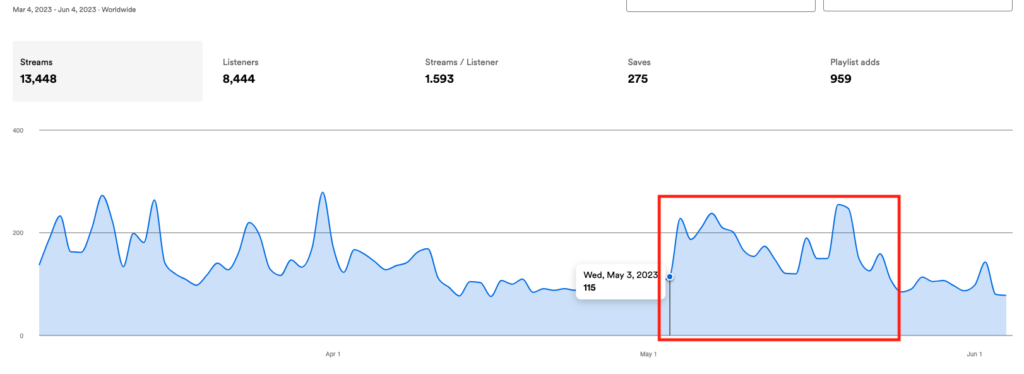
Most of those streams came from the “indie pop – happy/chill” playlist:
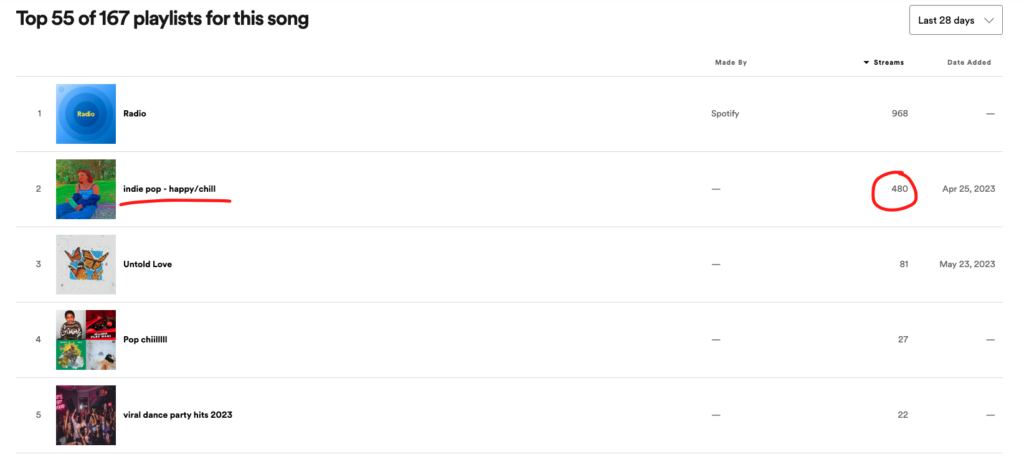
All told (as I said at the top of this post), that’s not a result that’s going to send Holly to network TV talk shows, but it is a respectable return on our $27 spend.
The pros and cons of SubmitLink
Okay, so that’s what happened. Here’s what I think about it all.
The good stuff
- I love this model, where you get to pick the playlists you submit to. It’s transparent. If you do your research, it basically ensures that you’ll only get on healthy, high-fit lists.
- Relatedly, all of the playlists I saw on the platform seemed healthy and engaged.
- SubmitLink is really affordable. I mean, come on, this campaign cost $27. Considering services like Playlist Push start above $200, that’s really good.
- I like Aaron’s ethos – he’s very collaborative. It’s hard to qualify or quantify this, but I think he does a nice job of listening to users and incorporating their feedback. SubmitLink, for example, has a recently-launched Community forum where you can share feature requests or suggestions. That’s cool.
The not-as-good stuff
- The biggest knock against SubmitLink, still, is that there just aren’t that many curators on the platform. SubmitHub and Groover have far more. This can limit your selection of playlists that fit your music, and, subsequently, your results.
- It’s not quite as slick as Groover or SubmitHub – Aaron is improving the interface over time, but the other two platforms have already had a lot of time and money poured into them. (Although, for what it’s worth, it’s improving quickly, and I still like SubmitLink’s UI overall.)
Final thoughts on SubmitLink
If you’ve read all of that – or if you’ve just skimmed down here – you’re probably looking for a bottom-line verdict. Here’s mine:
SubmitLink is a really nice platform that’s probably best used as a supplemental promotional option.
In other words, if SubmitLink is the only lever you’re pulling in your marketing, you probably won’t see your numbers get too high. It’s probably not big enough to be your main method of promotion.
But if you’re using something else – whether that’s Facebook ads, or yes, something like SubmitHub – then I think SubmitLink can be a great complement for your promotional efforts. It’s affordable, it’s transparent, and it works.
The bottom line is that I like SubmitLink a lot. Just don’t expect to end up on a label or a late night talk show after your next campaign.
All right, that’s all I’ve got on this one. Hope this review was helpful, and as always, here’s wishing you good luck as you make and market your music. It’s worth it.








